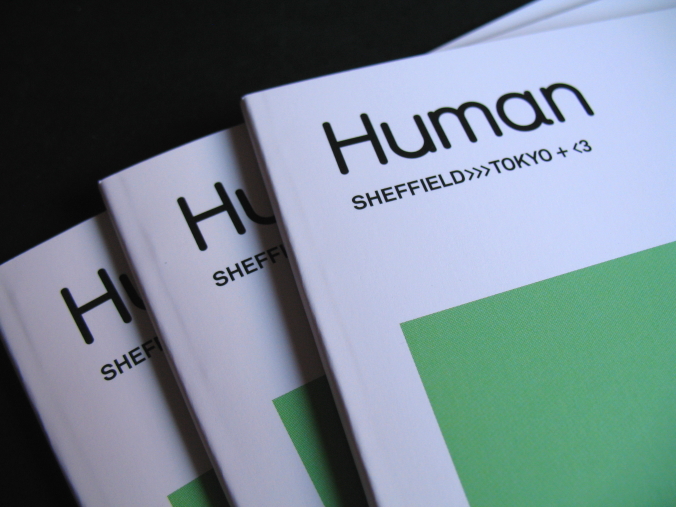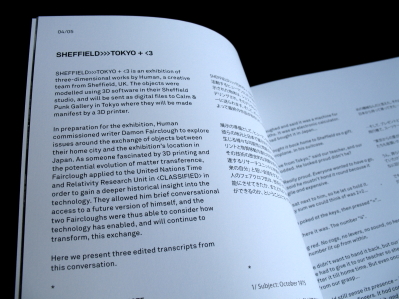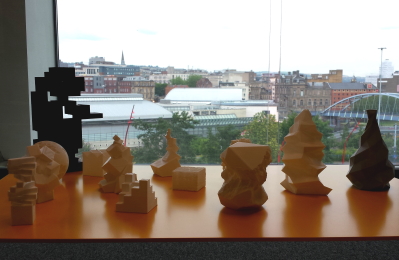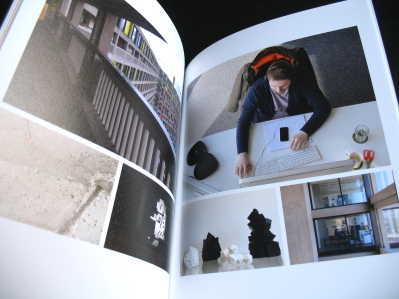Sheffield to Tokyo with love: writing for Human Studio
It was one of those briefs: “We’d like you to write something for us but we’re not sure what.” When Sheffield’s Human Studio commissioned me to write the catalogue introduction for their 2015 exhibition, SHEFFIELD>>>TOKYO + <3, I was bewitched by their vagueness. The result was a slice of sci-fi fiction with a time-travelling twist – six scene-setting pages that journeyed into my future and back. No further explanation necessary. Read on…

SHEFFIELD>>>TOKYO + <3 is an exhibition of three-dimensional works by Human, a creative team from Sheffield, UK. The objects were modelled using 3D software in their Sheffield studio, and will be sent as digital files to Calm & Punk Gallery in Tokyo where they will be made manifest by a 3D printer.
In preparation for the exhibition, Human commissioned writer Damon Fairclough to explore issues around the exchange of objects between their home city and the exhibition’s location in Japan. As someone fascinated by 3D printing and the potential evolution of matter transference, Fairclough applied to the United Nations Time and Relativity Research Unit in <CLASSIFIED> in order to gain a deeper historical insight into the technology. They allowed him brief conversational access to a future version of himself, and the two Faircloughs were thus able to consider how technology has enabled, and will continue to transform, this exchange.
Here we present three edited transcripts from this conversation.

1/ Subject: October 1975
DF#2015: The first thing I’d like to ask is this: do you still remember the first time we were really aware of holding an object from Japan?
DF#2056: Yes. It was the autumn of ’75, and it felt like it had been handed to us from the future. We’d heard of such devices, but never seen one before. Our friend brought it into school to show to the class after his dad brought it back from a trip to Tokyo.
DF#2015: That’s right. Our teacher asked him to stand up and tell everyone how it worked.
DF#2056: He thought she meant he should explain its electronics, and he looked as if he was going to cry. He didn’t know how it worked did he?
DF#2015: Of course not. He was only eight.
DF#2056: But she smiled and said she didn’t want to know its secret. She just wanted him to tell us what it was for.
DF#2015: And he laughed and said it was a machine for doing maths. It was an electronic calculator. His dad had bought it in Japan…
DF#2056: …and brought it back home to Sheffield as a gift. On an aeroplane. In his suitcase.
DF#2015: “With love from Tokyo,” said our teacher, and our friend nodded. He looked proud didn’t he?
DF#2056: He did. Really proud. Everyone wanted to have a go, but she said he mustn’t hand it round because it was fragile and expensive.
DF#2015: But we sat next to him, so he let us hold it. The only sum we could think of was 2+2…
DF#2056: …so we poked at the keys, then pressed ‘=’…
DF#2015: …and there it was. The number ‘4’.
DF#2056: Glowing red. No cogs, no levers, no sound, no heat. Just a number lit up from within.
DF#2015: And we didn’t want to hand it back, but our friend said he had to give it to our teacher so she could look after it till home time. But even once it was gone from our grasp…
DF#2056: …we could still sense its presence – its plastic form beneath our fingers. It had come from Tokyo to Sheffield, and we’d held it, and would remember how it felt for…
DF#2015: …the rest of our life.
—

2/ Subject: October 2015
DF#2015: So… this is where it gets interesting. Because I need to ask you about something that hasn’t happened to me yet… but which is in your past.
DF#2056: Well… it’s our past really. But I take your point.
DF#2015: Nick Bax from the Human creative agency has been talking to me about an exhibition project that makes use of a 3D printer. Do you remember when you… we… first saw it working?
DF#2056: Of course. It was like a ghost drawing in space – though we knew it wasn’t a transmission from the spirit world.
DF#2015: No, not from the spirit world. A transmission from Sheffield…
DF#2056: …to Tokyo. With love from the people at Human.
DF#2015: Nick showed us the machine when we visited the Human studio…
DF#2056: …but we didn’t see it working that day. He didn’t turn it on. He described the process though didn’t he?
DF#2015: He did. And as he spoke, we gazed at the machine – a MakerBot Replicator – and we tried to imagine it sketching objects in the air.
DF#2056: I remember that we said the mechanism looked a bit like a 3D Etch-A-Sketch, which made Nick laugh. He said it sort of worked the same way.
DF#2015: Yes, but we still felt a little stupid. As if we wanted to delete our comment and backspace through time.
DF#2056: We felt embarrassed. Though I’m not sure why?
DF#2015: Maybe it was because it made us sound old.
DF#2056: Yes, perhaps. Though we were… what?
DF#2015: Forty-eight. I’m forty-eight.
DF#2056: Right. That doesn’t sound so old to me now.
DF#2015: So what did we think when we first saw the machine working at the exhibition in Tokyo?
DF#2056: We thought we’d stepped into the future. Just like when we first saw…
DF#2015: A calculator?
DF#2056: Exactly! We watched the objects appear in space – objects that had been imagined by the team at Human in Sheffield, and modelled on screens, and sent as code across continents. We thought they looked like detritus from the workings of the universe. Some looked crystalline, others seemed to have tumbled out of the cosmos. They felt solid, yet they were made from the DNA of an idea.
DF#2015: It sounds like a significant moment. The beginning of a new way of sending thoughts, ideas, as physical objects.
DF#2056: Yes, I remember thinking at the time that this process – this ‘printing’ in three dimensions – was the beginning of something that would alter everything. Transform people’s lives. But I can see now that it wasn’t the beginning. It was just an exchange that had been going on for…
DF#2015: …years.
DF#2056: Yes, many years. It did transform lives though. It transformed ours.
—

3/ Subject: October 2055
DF#2015: The technology must have developed so quickly from that point. Can you tell me how it felt when…
DF#2056: Of course! I suppose the thought originally occurred to us at that 2015 exhibition in Tokyo.
DF#2015: That we wanted to move there, to live?
DF#2056: Yes. But as is the way of things, we didn’t do anything about it. Not until…
DF#2015: …the arrival of matter transference technology?
DF#2056: That’s right. It developed surprisingly quickly – really, you’ll be amazed. There was a big breakthrough about a decade ago when they ran a successful trial using ArtiDerma specimens.
DF#2015: ArtiDerma?
DF#2056: An artificially reared organic substance that can mimic a variety of human internal systems. They use it in medical research. They managed to transfer the specimens from one building to another about a kilometre away.
DF#2015: Without damage?
DF#2056: There were minor mutations, but it was big news. A huge achievement.
DF#2015: And… transferring people?
DF#2056: The system was in beta testing for five or six years, but it’s been available commercially for just over a year now. We signed up for one of the first transmissions in October 2055.
DF#2015: Have you ever tried to describe it? The actual moment?
DF#2056: Not out loud, though I’ve thought about it often. It was like… a peeling apart. As if our soul had been sliced in half.
DF#2015: Can you talk me through the process?
DF#2056: It was thrilling to get the chance, obviously, but in many ways it wasn’t actually very dramatic when the time came. We entered the booth, gave the lockdown command, heard the seal engage…
DF#2015: Claustrophobic?
DF#2056: Very. But bearable. And then the operator initiated the scan. There was a beam of light that travelled over our body – it took a couple of minutes – and a DNA probe that scooped cells from our mouth. And there was a pause – and then it happened.
DF#2015: You… we… were transferred. From Sheffield.
DF#2056: To Tokyo, yes.
DF#2015: And this really happens? In our lifetime?
DF#2056: Well… yes. You’d be surprised how normal it now seems from this perspective. Everyone’s doing it. It’s by far the easiest way to travel.
DF#2015: And is it safe?
DF#2056: Usually. Our fingernails went missing during the transfer, but we can manage without them.
DF#2015: It sounds… remarkable.
DF#2056: I’m sure it does. But that’s what happens with technology. The unimaginable becomes commonplace.
DF#2015: From printing objects in space…
DF#2056: …to sending the human body across the globe in an instant.
DF#2015: One endless sequence. From Sheffield.
DF#2056: From Tokyo.
DF#2015: With…
DF#2056: …love.
—
Damon Fairclough
Sheffield/Tokyo
2015/2056

Text and images © Damon Fairclough 2015
SHEFFIELD>>>TOKYO + <3 ran at Calm & Punk Gallery, Tokyo, from 3 November until 18 November 2015.
Many thanks to Nick Bax and the team at Human Studio, Sheffield, for commissioning this piece.
Share this article
Follow me